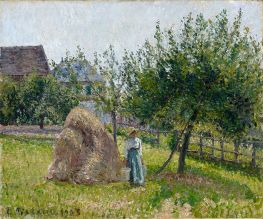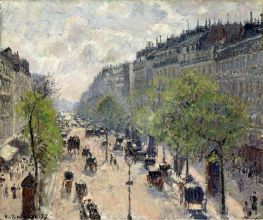
Camille Jacob Pissarro Painting Reproductions 22 of 22
1830-1903
French Impressionist Painter
Camille Pissarro (July 10, 1830 - November 13, 1903) was a French Impressionist painter. His importance resides not only in his visual contributions to Impressionism and Post-Impressionism, but also in his patriarchal standing among his colleagues, particularly Paul Cezanne.
Early life and work
Camille Jacob Pissarro was born in Charlotte Amalie, St. Thomas to Abraham Gabriel Pissarro, a Portuguese Sephardic Jew, and Rachel Manzano-Pomie, from the Dominican Republic. Pissarro lived in St. Thomas until age 12, when he went to a boarding school in Paris. He returned to St. Thomas where he drew in his free time. Pissarro was attracted to political Anarchy, an attraction that may have originated during his years in St. Thomas. In 1852, he travelled to Venezuela with the Danish artist Fritz Melbye. In 1855, he moved to Paris, where he studied informally with the French landscape artist Jean-Baptiste Camille Corot.
His finest early works (See Jalais Hill, Pontoise, Metropolitan Museum of Art, New York) are characterized by a broadly painted (sometimes with palette knife) naturalism derived from Courbet, but with an incipient Impressionist palette.
Camille Pissarro married Julie Vellay, a maid in his mother's household. Of their eight children together, one died at birth and a daughter died when nine. The surviving children all painted, and Lucien, the oldest son, became a follower of William Morris.
Artist and mentor
Known as the Father of Impressionism, Pissarro painted rural and urban French life, particularly landscapes in and around Pontoise, as well as scenes from Montmartre. His mature work displays an empathy for peasants and laborers, and sometimes evidences his radical political leanings. He was a mentor to Paul Cezanne and Paul Gauguin and his example inspired many younger artists, including Californian Impressionist Lucy Bacon.
Pissarro's influence on his fellow Impressionists is probably still underrated; not only did he offer substantial contributions to Impressionist theory, but he also managed to remain on friendly, mutually respectful terms with such difficult personalities as Edgar Degas, Cezanne and Gauguin. Pissarro exhibited at all eight of the Impressionist exhibitions. Moreover, whereas Monet was the most prolific and emblematic practitioner of the Impressionist style, Pissarro was nonetheless a primary developer of Impressionist technique.
Pissarro experimented with Neo-Impressionist ideas between 1885 and 1890. Discontented with what he referred to as "romantic Impressionism", he investigated Pointillism which he called "scientific Impressionism" before returning to a purer Impressionism in the last decade of his life.
In March 1893, Paris Gallery Durand-Ruel organized a major exhibition of 46 of Pissarro's works along with 55 others by Antonio de La Gandara. But while the critics acclaimed Gandara, their appraisal of Pissarro's art was less enthusiastic.
Pissarro died in Eragny-sur-Epte on either November 12 or November 13, 1903 and was buried in Pere Lachaise Cemetery in Paris.
During his lifetime, Camille Pissarro sold few of his paintings. By 2005, however, some of his works were selling for over U.S. $4 million.
Early life and work
Camille Jacob Pissarro was born in Charlotte Amalie, St. Thomas to Abraham Gabriel Pissarro, a Portuguese Sephardic Jew, and Rachel Manzano-Pomie, from the Dominican Republic. Pissarro lived in St. Thomas until age 12, when he went to a boarding school in Paris. He returned to St. Thomas where he drew in his free time. Pissarro was attracted to political Anarchy, an attraction that may have originated during his years in St. Thomas. In 1852, he travelled to Venezuela with the Danish artist Fritz Melbye. In 1855, he moved to Paris, where he studied informally with the French landscape artist Jean-Baptiste Camille Corot.
His finest early works (See Jalais Hill, Pontoise, Metropolitan Museum of Art, New York) are characterized by a broadly painted (sometimes with palette knife) naturalism derived from Courbet, but with an incipient Impressionist palette.
Camille Pissarro married Julie Vellay, a maid in his mother's household. Of their eight children together, one died at birth and a daughter died when nine. The surviving children all painted, and Lucien, the oldest son, became a follower of William Morris.
Artist and mentor
Known as the Father of Impressionism, Pissarro painted rural and urban French life, particularly landscapes in and around Pontoise, as well as scenes from Montmartre. His mature work displays an empathy for peasants and laborers, and sometimes evidences his radical political leanings. He was a mentor to Paul Cezanne and Paul Gauguin and his example inspired many younger artists, including Californian Impressionist Lucy Bacon.
Pissarro's influence on his fellow Impressionists is probably still underrated; not only did he offer substantial contributions to Impressionist theory, but he also managed to remain on friendly, mutually respectful terms with such difficult personalities as Edgar Degas, Cezanne and Gauguin. Pissarro exhibited at all eight of the Impressionist exhibitions. Moreover, whereas Monet was the most prolific and emblematic practitioner of the Impressionist style, Pissarro was nonetheless a primary developer of Impressionist technique.
Pissarro experimented with Neo-Impressionist ideas between 1885 and 1890. Discontented with what he referred to as "romantic Impressionism", he investigated Pointillism which he called "scientific Impressionism" before returning to a purer Impressionism in the last decade of his life.
In March 1893, Paris Gallery Durand-Ruel organized a major exhibition of 46 of Pissarro's works along with 55 others by Antonio de La Gandara. But while the critics acclaimed Gandara, their appraisal of Pissarro's art was less enthusiastic.
Pissarro died in Eragny-sur-Epte on either November 12 or November 13, 1903 and was buried in Pere Lachaise Cemetery in Paris.
During his lifetime, Camille Pissarro sold few of his paintings. By 2005, however, some of his works were selling for over U.S. $4 million.
506 Pissarro Paintings

Apple Trees in Eragny, Sunny Morning 1903
Oil Painting
$643
$643
Canvas Print
$66.33
$66.33
SKU: PIC-19365
Camille Jacob Pissarro
Original Size: 54.6 x 65.8 cm
Kunstmuseum, Basel, Switzerland
Camille Jacob Pissarro
Original Size: 54.6 x 65.8 cm
Kunstmuseum, Basel, Switzerland

Boulevard Montmartre, Spring 1897
Oil Painting
$776
$776
Canvas Print
$66.72
$66.72
SKU: PIC-19756
Camille Jacob Pissarro
Original Size: 46 x 55.2 cm
Museum Langmatt, Baden, Switzerland
Camille Jacob Pissarro
Original Size: 46 x 55.2 cm
Museum Langmatt, Baden, Switzerland